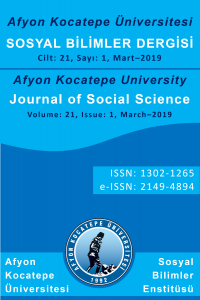Structural Changes and Purchasing Power Parity in Turkish Exchange Rates
Öz
We re-examine the purchasing power parity (PPP) hypothesis for Turkey by concentrating on modelling structural changes as sharp (with dummy variables) and smooth (with a Fourier approximation) process. The results show (i) more evidence in favor of PPP hypothesis when structural changes are taken into account and (ii) modelling the shifts with different approaches plays a crucial role for policy implications.
Kaynakça
- Adigüzel, U, Şahbaz, A., Özcan, C. C. and Nazlioğlu, Ş. (2014). “The Behavior of Turkish Exchange Rates: A Panel Data Perspective”, Economic Modelling, 42, pp. 117-185.
- Bahmani-Oskooee, M., Chang, T., Liu W. C. (2014). “Revisiting Purchasing Power Parity in 34 OECD Countries: Sequential Panel Selection Method”, Applied Economics Letters 21(18), pp.1283-1287.
- Becker, R., Enders, W. and Lee, J. (2006). “A Stationarity Test in The Presence of an Unknown Number of Smooth Breaks”, Journal of Time Series Analysis 27, pp. 381–409.
- Carrion-I-Silvestre, J. L. and Sansó, A. (2007). “The KPSS Test with Two Structural Breaks”, Spanish Economic Review 9(2), pp. 105-127.
- Dickey, D. A. and Fuller, W. A. (1981). “Likelihood Ratio Statistics for Autoregressive Time Series with a Unit Root”, Econometrica, 49, pp. 1057-1072.
- Enders, W. and Lee, J. (2012). “The Flexible Fourier Form and Dickey-Fuller Type Unit Root Tests”, Economics Letters 117, pp. 196-199.
- Karagöz, K. ve Saraç, B. (2016). “Testing the Validity of PPP Theory for Turkey: Nonlinear Unit Root Testing”, Procedia Economics and Finance 38, pp. 458 – 467.
- Kurozumi, E. (2002). “Testing for Stationarity with a Break”, Journal of Econometrics 108(1), pp. 63-99.
- Kwiatkowski, D., Phillips, P. C.B., Schmidt, P. and Shin, Y. (1992). “Testing the Null Hypothesis of Stationary against the Alternative of a Unit Root”, Journal of Econometrics 54, pp. 159–178.
- Lee, J., Huang, C. J. and Shin, Y. (1997). “On Stationary Tests in the Presence of Structural Breaks”, Economics Letters 55, pp. 165-172.
- Narayan, P. K. and POPP, S. (2010). “A New Unit Root Test with Two Structural Breaks in Level and Slope at Unknown Time”, Journal of Applied Statistics 37(9), pp. 1425-1438.
- Perron, P. (1989). “The Great Crash, the Oil Price Shock, and the Unit Root Hypothesis”, Econometrica 57, pp. 1361-1401.
- Sul, D., Phillips, P. and Choi, C. (2005). “Prewhitening Bias in HAC Estimation”, Oxford Bulletin of Economics and Statistics 67(4), pp. 517-546.
- Zivot, E. and Andrews, D.W.K. (1992). “Further Evidence on the Great Crash, the Oil-Price Shock, and the Unit-Root Hypothesis”, Journal of Business & Economics- Statistics 10, pp. 251-270.
Structural Changes and Purchasing Power Parity in Turkish Exchange Rates
Öz
We re-examine the purchasing
power parity (PPP) hypothesis for Turkey by concentrating on modelling
structural changes as sharp (with dummy variables) and smooth (with a Fourier
approximation) process. The results show (i) more evidence in favor of PPP hypothesis
when structural changes are taken into account and (ii) modelling the shifts
with different approaches plays a crucial role for policy implications.
Anahtar Kelimeler
Kaynakça
- Adigüzel, U, Şahbaz, A., Özcan, C. C. and Nazlioğlu, Ş. (2014). “The Behavior of Turkish Exchange Rates: A Panel Data Perspective”, Economic Modelling, 42, pp. 117-185.
- Bahmani-Oskooee, M., Chang, T., Liu W. C. (2014). “Revisiting Purchasing Power Parity in 34 OECD Countries: Sequential Panel Selection Method”, Applied Economics Letters 21(18), pp.1283-1287.
- Becker, R., Enders, W. and Lee, J. (2006). “A Stationarity Test in The Presence of an Unknown Number of Smooth Breaks”, Journal of Time Series Analysis 27, pp. 381–409.
- Carrion-I-Silvestre, J. L. and Sansó, A. (2007). “The KPSS Test with Two Structural Breaks”, Spanish Economic Review 9(2), pp. 105-127.
- Dickey, D. A. and Fuller, W. A. (1981). “Likelihood Ratio Statistics for Autoregressive Time Series with a Unit Root”, Econometrica, 49, pp. 1057-1072.
- Enders, W. and Lee, J. (2012). “The Flexible Fourier Form and Dickey-Fuller Type Unit Root Tests”, Economics Letters 117, pp. 196-199.
- Karagöz, K. ve Saraç, B. (2016). “Testing the Validity of PPP Theory for Turkey: Nonlinear Unit Root Testing”, Procedia Economics and Finance 38, pp. 458 – 467.
- Kurozumi, E. (2002). “Testing for Stationarity with a Break”, Journal of Econometrics 108(1), pp. 63-99.
- Kwiatkowski, D., Phillips, P. C.B., Schmidt, P. and Shin, Y. (1992). “Testing the Null Hypothesis of Stationary against the Alternative of a Unit Root”, Journal of Econometrics 54, pp. 159–178.
- Lee, J., Huang, C. J. and Shin, Y. (1997). “On Stationary Tests in the Presence of Structural Breaks”, Economics Letters 55, pp. 165-172.
- Narayan, P. K. and POPP, S. (2010). “A New Unit Root Test with Two Structural Breaks in Level and Slope at Unknown Time”, Journal of Applied Statistics 37(9), pp. 1425-1438.
- Perron, P. (1989). “The Great Crash, the Oil Price Shock, and the Unit Root Hypothesis”, Econometrica 57, pp. 1361-1401.
- Sul, D., Phillips, P. and Choi, C. (2005). “Prewhitening Bias in HAC Estimation”, Oxford Bulletin of Economics and Statistics 67(4), pp. 517-546.
- Zivot, E. and Andrews, D.W.K. (1992). “Further Evidence on the Great Crash, the Oil-Price Shock, and the Unit-Root Hypothesis”, Journal of Business & Economics- Statistics 10, pp. 251-270.
Ayrıntılar
| Birincil Dil | İngilizce |
|---|---|
| Bölüm | Makaleler |
| Yazarlar | |
| Yayımlanma Tarihi | 20 Mart 2019 |
| Gönderilme Tarihi | 18 Ekim 2018 |
| Yayımlandığı Sayı | Yıl 2019 Cilt: 21 Sayı: 1 |

This work is licensed under a Creative Commons Attribution-NonCommercial-NoDerivatives 4.0 International License.


